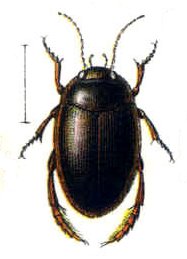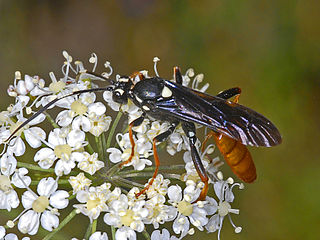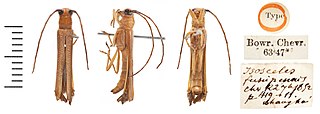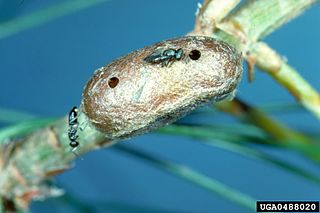The Grand Comore drongo is a species of bird in the family Dicruridae. It is endemic to Comoros.

The Syrphinae constitute one of the three subfamilies of the fly family Syrphidae. Most larvae of this subfamily feed on aphids. It is a monophyletic group with more than 1,600 species.

Agabus fuscipennis is a species of beetle native to the Palearctic and the Nearctic. In Europe, it is only found in Austria, Belarus, the Czech Republic, mainland Denmark, Estonia, Finland, Germany, mainland Italy, Kaliningrad, Latvia, Lithuania, mainland Norway, Poland, Russia, Sardinia, Sicily, Slovakia, Sweden, and Ukraine.
Copelatus fuscipennis is a species of diving beetle. It is part of the genus Copelatus in the subfamily Copelatinae of the family Dytiscidae. It was described by Sharp in 1882.

Amblyjoppa fuscipennis is a species of the parasitic wasp in the family Ichneumonidae. It was first described by Constantin Wesmael in 1844.

Sophronica is a genus of longhorn beetles of the subfamily Lamiinae, containing the following species:

Trigona fuscipennis is a stingless bee species that originates in Mexico but is also found in Central and South America. They are an advanced eusocial group of bees and play a key role as pollinators in wet rainforests. The species has many common names, including mapaitero, sanharó, abelha-brava, xnuk, k'uris-kab, enreda, corta-cabelo, currunchos, zagaño, and enredapelos.
Sophronica bimaculipennis is a species of beetle in the family Cerambycidae. It was described by Stephan von Breuning in 1955, originally under the genus Sophronisca. It is known from Ghana, the Ivory Coast, and Guinea. It contains the varietas Sophronica bimaculipennis var. besnardi.
Sophronica postscutellaris is a species of beetle of the genus Sophronica, in the family Cerambycidae. It was described by Stephan von Breuning in 1954.
Sophronica rufobasiantennalis is a species of beetle in the family Cerambycidae. It was described by Stephan von Breuning in 1948. It contains the varietas Sophronica rufobasiantennalis var. ovalis.
Sophronica rufulescens is a species of beetle in the family Cerambycidae. It was described by Stephan von Breuning in 1940. It feeds on the Monterey pine.
Sophronica subdivisa is a species of beetle in the family Cerambycidae. It was first described by Stephan von Breuning in 1940.
Sophronica angusticollis is a species of beetle in the family Cerambycidae. It was described by Per Olof Christopher Aurivillius in 1928. It is known from Somalia, Ethiopia, Tanzania, and Kenya.
Sophronica grisea is a species of beetle in the family Cerambycidae. It was described by Per Olof Christopher Aurivillius in 1908.
Sophronica amplipennis is a species of beetle in the family Cerambycidae. It was described by Francis Polkinghorne Pascoe in 1888.

Oberea fuscipennis is a species of beetle in the family Cerambycidae. It was described by Chevrolat in 1852.

Dahlbominus fuscipennis, the sawfly parasitic wasp, is a species of chalcid wasp from the family Eulophidae which parasitizes the European pine sawfly Neodiprion sertifer, among other hosts. It is the only species in the genus Dahlbominus.
Phytocoris fuscipennis is a species of plant bug in the family Miridae. It is found in North America.

Ocyptamus fuscipennis is a species of syrphid fly in the family Syrphidae. This fly can be found throughout North America, as well as in Cuba. In Puerto Rico, this species in its larval stage is an predator of autumn cohorts of Toxoptera citricida. Adult flies are known to visit Xyris tennesseensis flowers.







